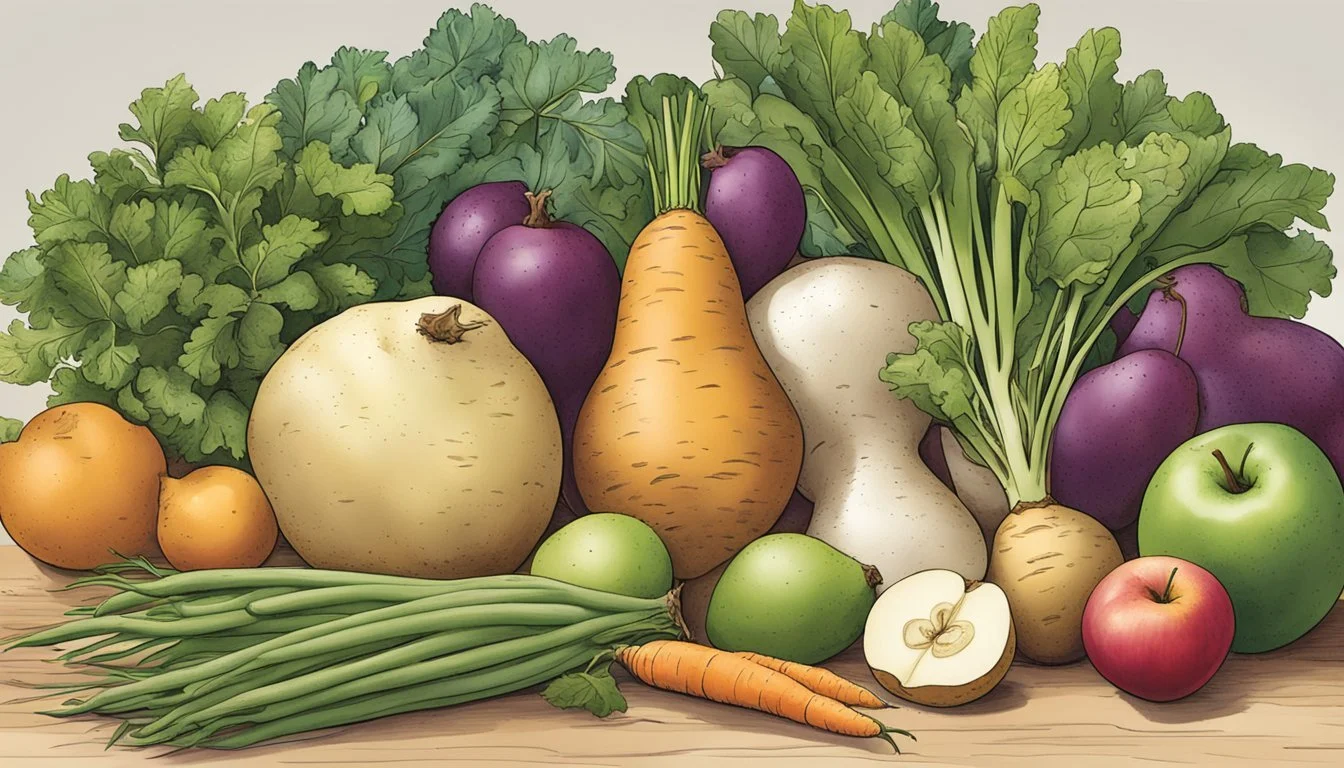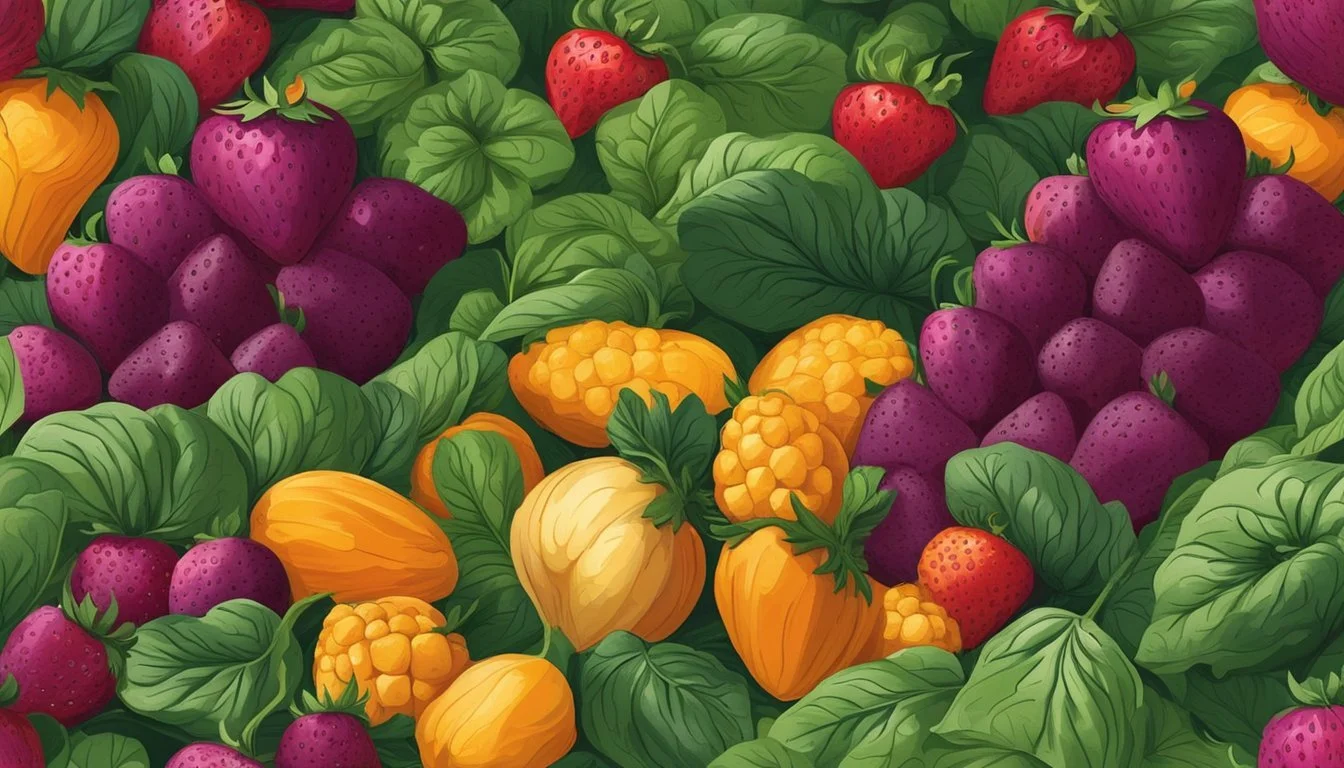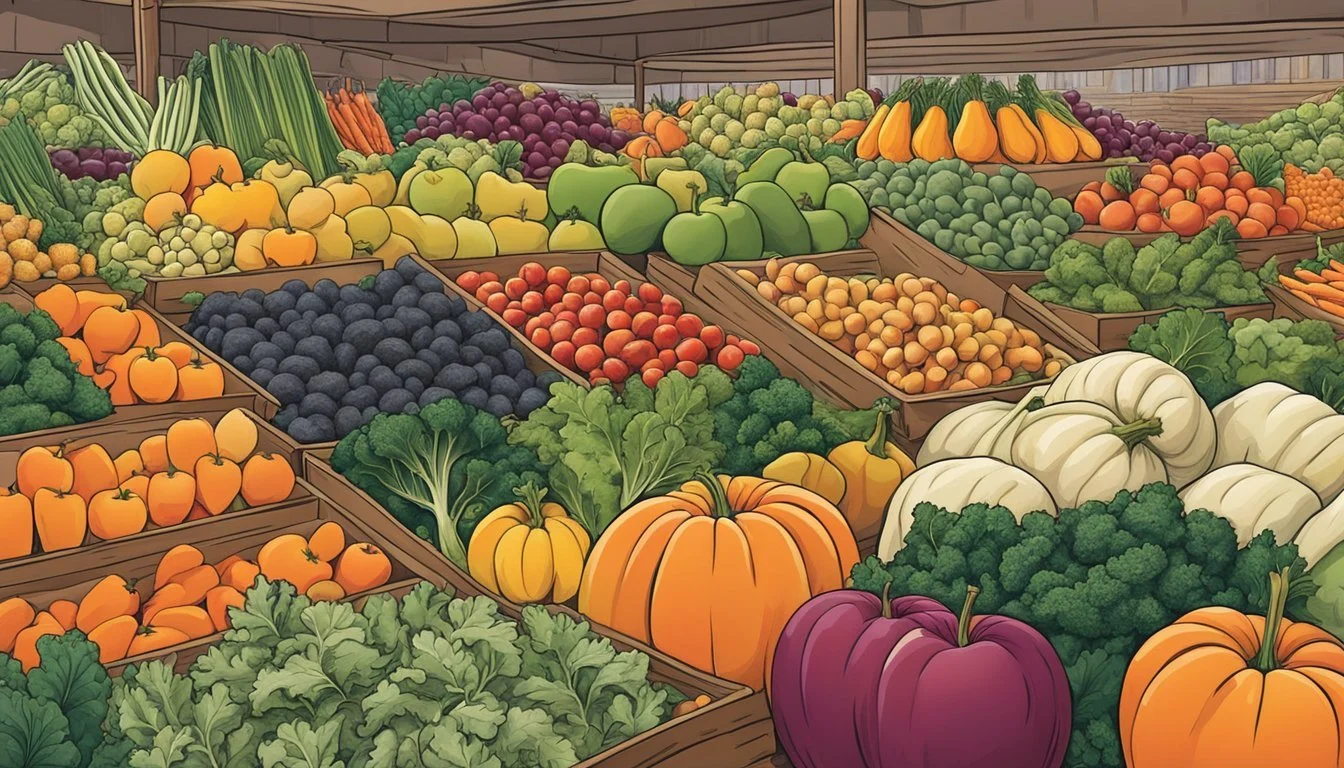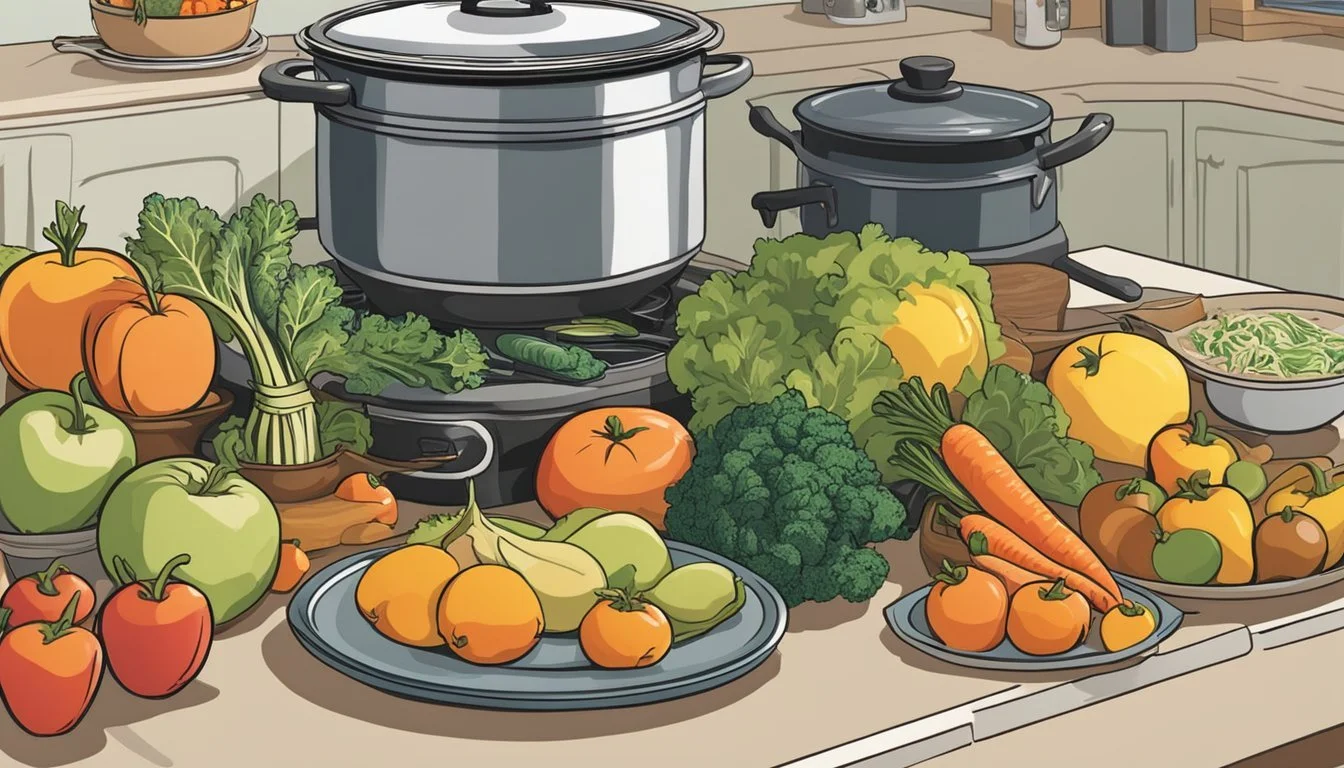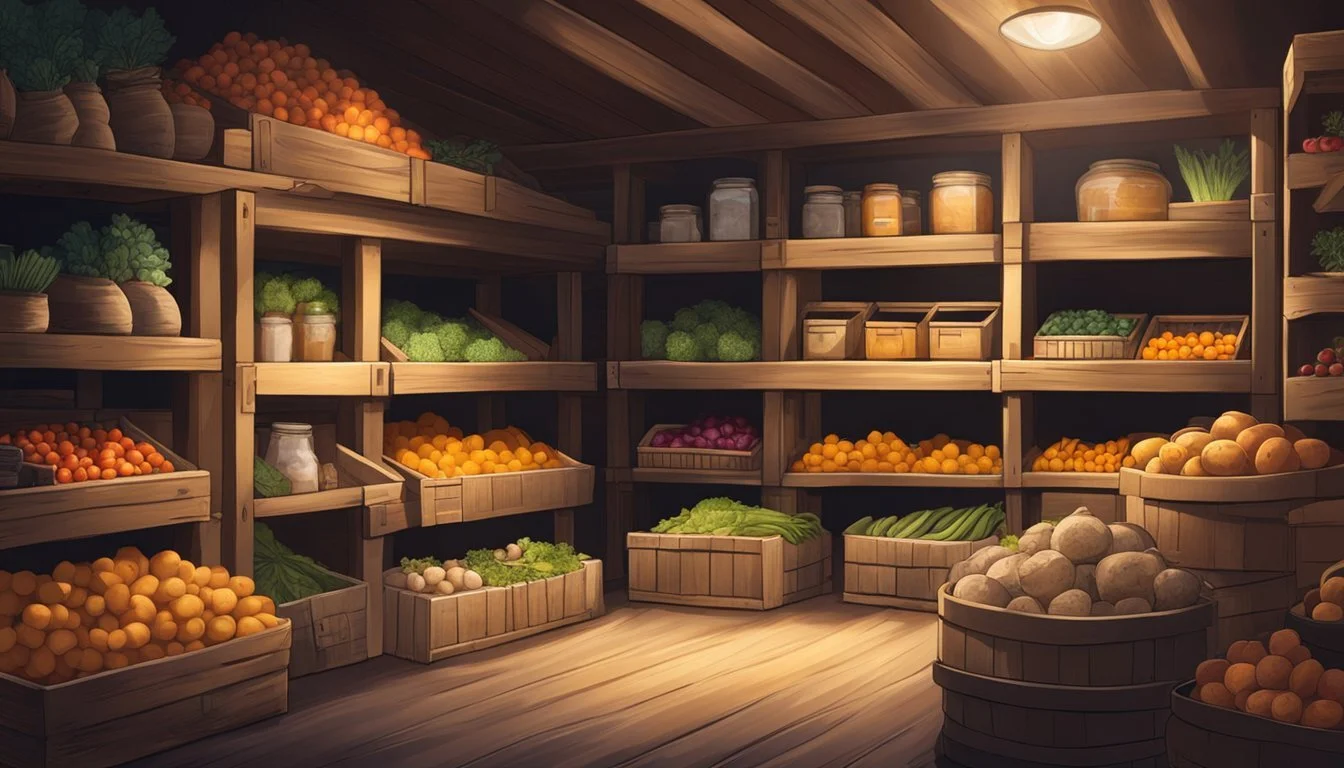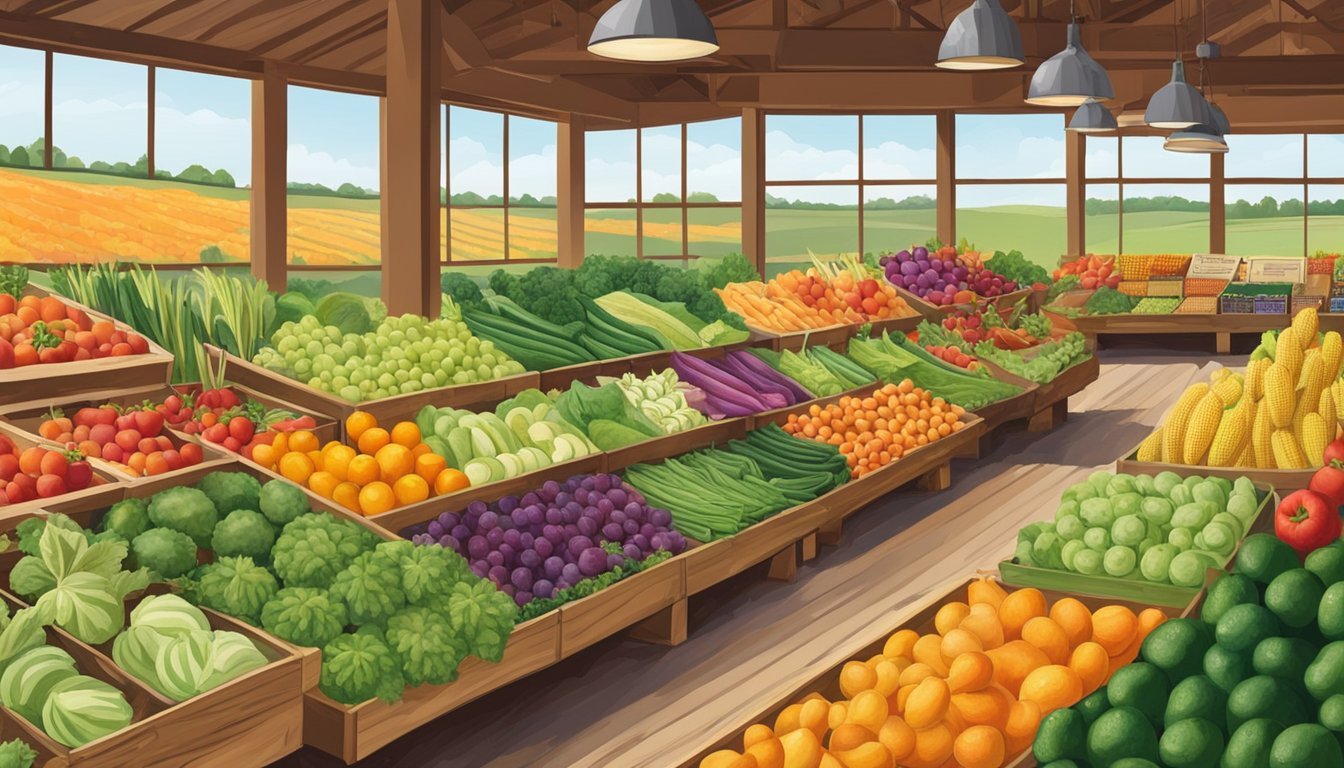South Dakota Seasonal Fruit & Vegetables in February
A Buyer's Guide
This Article is Part of our South Dakota Seasonal Fruit & Veg Calendar
February in South Dakota is typically marked by chilly temperatures and a landscape resting under a blanket of snow. Despite the frigid climate, there remains a selection of seasonal produce available to those seeking fresh fruits and vegetables. The local agriculture extends through the winter months by focusing on crops that are tolerant to the cold and those that store well from previous harvests.
While fruit options may be limited during this time, residents still enjoy the last of the stored apples (how long do apples last?) from the fall. In terms of vegetables, choices are heartier. Root vegetables like potatoes and carrots (how long do carrots last?), which are harvested in the fall and store well, continue to be staples in South Dakota kitchens. Additionally, cold-hardy greens such as kale (What wine goes well with kale?) and spinach thrive in these colder conditions, offering fresh options for salads and cooking.
South Dakota's agricultural resilience in February displays a keen adaptation to the regional climate. Farming practices and crop selection are finely tuned to make the most of the growing seasons, ensuring that even in the depths of winter, there is a variety of local produce to be found. This demonstrates a commitment to sustainability and support for local economies, as well as the ingenuity of farmers in the state.
Seasonal Highlights
South Dakota’s February may be cold and wintery, but its markets offer an abundant array of seasonal fruits and vegetables known for their vibrant flavor. Here, the emphasis is on citrus fruits and hearty vegetables that can withstand the cooler temperatures.
Top Fruits
Citrus: This is the peak time for citrus fruits, promising a burst of tangy sweetness and vibrant flavor. Shoppers can find a variety of oranges, including the navel and the unique blood oranges, known for their deep red flesh. Additionally, grapefruits such as the ruby variety are in full supply, perfect for a fresh, tangy addition to breakfast or salads.
Hybrid Varieties: Look out for Meyer lemons, a sweeter relative of the standard lemon, as well as kumquats and pomelos, which are less common but provide a delightful mix of bitter and sweet tastes.
Top Vegetables
Root Vegetables: These remain stalwarts of winter, with carrots and beets available, both ideal for adding sweetness and earthy tones to dishes.
Cruciferous Vegetables: Hearty cruciferous vegetables like cabbage and kale are in season, offering a blend of textures and rich flavors to winter meals. They are not only versatile in the kitchen but also packed with nutrients.
Focusing on these seasonal offerings ensures the freshest produce packed with the fullest flavor during the winter months in South Dakota.
Health Benefits
Consuming seasonal fruits and vegetables in South Dakota provides essential nutrients that support overall health. Fresh produce in February tends to be limited, but the available items like root vegetables and cruciferous vegetables contribute to a well-rounded diet.
Nutritional Value
Root vegetables, commonly available during the colder months in South Dakota, are rich in fiber, vitamins, and minerals. For example, carrots and sweet potatoes (What wine goes well with sweet potatoes?) are high in beta-carotene and vitamin A, supporting immune function and eye health. Cruciferous vegetables such as kale and brussels sprouts (how long do brussels sprouts last?) boast high levels of vitamin C and cancer-fighting glucosinolates. These nutrient-dense foods are pivotal for maintaining good health, especially during winter when the body needs extra nutrients.
Root Vegetables: Potatoes, carrots, turnips
Fiber: Aids in digestion and weight management
Beta-Carotene: Converts to vitamin A, vital for vision and immunity
Vitamin C: Essential for tissue repair and immune system support
Cruciferous Vegetables: Kale, brussels sprouts, broccoli
Fiber: Promotes a healthy digestive system
Vitamin C: Critical for maintaining connective tissue and overall health
Glucosinolates: Sulphur-containing chemicals with potential cancer-preventative properties
Dietary Importance
Incorporating a variety of vegetables into one's diet is crucial. Dietary guidelines suggest adults consume 2-3 cups of vegetables daily, yet many fall short of this recommendation. South Dakota's winter offerings, including fiber-rich vegetables, are vital for maintaining a feeling of fullness, which can assist with weight management. Fresh veggies such as kale can be scarce in winter, but when available, they offer a burst of nutrients that are especially valuable during a season with fewer fresh options. Including these vegetables in one’s diet is essential for obtaining the necessary nutrients for good health.
Fiber: Present in both fresh produce and root vegetables, helps regulate the digestive system and keeps one satiated.
Vitamins and Minerals: Seasonal veggies provide vitamins A and C, among others, that bolster the immune system and promote cellular health during a month with high susceptibility to illnesses.
Cooking and Recipes
Seasonal produce in February in South Dakota consists of a variety of root vegetables and hearty greens that lend themselves to nourishing and flavorful dishes. Chefs and home cooks can take advantage of these in-season ingredients to create warm and comforting meals during the cold winter months.
Side Dishes
In side dishes, root vegetables like beets and carrots are key ingredients. They can be roasted to enhance their natural sweetness or mashed for a soft, comforting texture. A favorite recipe might include roasted beets with a hint of thyme.
Roasted Root Vegetables
Ingredients: Beets, carrots, olive oil, thyme, salt, pepper.
Instructions: Toss chopped vegetables with oil and herbs; bake until tender.
Main Courses
For main courses, chefs often use seasonal produce such as squash and kale. They might prepare a stuffed acorn squash with quinoa (how long does quinoa last?) and kale, providing a balanced dish that is both nutritious and satisfying.
Stuffed Acorn Squash
Ingredients: Acorn squash, quinoa, kale, parmesan, spices.
Instructions: Roast the squash, cook quinoa, sauté kale, combine and fill squash halves, and bake with a sprinkle of cheese.
Soups and Stews
Soups and stews are staples during this month. A robust kale and white bean stew is not only heartwarming but also rich in vitamins and protein.
Kale and White Bean Stew
Ingredients: Kale, white beans, broth, onions, garlic, seasonings.
Instructions: Sauté onions and garlic, add chopped kale, beans, broth, and simmer.
Desserts and Sweet Treats
Lastly, desserts incorporate elements like apples which are still available in February. Baked apples filled with nuts (how long do nuts last?) and a touch of local honey make for delightful sweet treats.
Honey Baked Apples
Ingredients: Apples, nuts, honey, cinnamon.
Instructions: Core apples, fill with nuts and honey, bake, and serve warm with a sprinkle of cinnamon.
Winter Storage and Preservation
In South Dakota, proper storage and preservation techniques are essential during February to maintain the quality and extend the shelf life of root vegetables, winter squash, onions, potatoes, and sweet potatoes. These methods aim to retain nutrient content and flavor until consumption.
Storage Tips
Root Vegetables: They should be stored in a cool, dark, and humid environment; a root cellar or a similar storage area with temperatures between 32°F and 40°F is ideal. Vegetables like beets and carrots can be placed in boxes of damp sand to maintain humidity.
Winter Squash: Varieties such as butternut and acorn squash can stay fresh for several months when stored in a well-ventilated room at 50°F to 60°F. It's advised to keep them off the ground to prevent rotting.
Onions & Potatoes: They require a cool, dark place with moderate humidity. It's crucial to keep them separate to prevent the potatoes from sprouting. For example, onions are best stored in mesh bags to allow airflow, while potatoes favor dark bins or paper bags to discourage light exposure and subsequent greening.
Sweet Potatoes: They are best kept at slightly higher temperatures, around 55°F to 60°F, and in a dark location to prevent sprouting.
Preservation Techniques
Dry Storage: This involves storing crops in conditions that are low in moisture and high in airflow to prevent decay and sprouting. Sweet potatoes and winter squash are particularly versatile in storage, lending themselves well to this method.
Canning: Preservation for crops such as potatoes or sweet potatoes can be achieved by canning, where they are processed at high temperatures and sealed in airtight containers.
Freezing: Another effective method for many vegetables, including squashes and sweet potatoes. It involves blanching the vegetables first to preserve texture, flavor, and nutritional value.
Table 1: Preservation Temperatures and Methods
Vegetable Ideal Temp (°F) Humidity Preservation Method Shelf Life Root Vegetable 32-40 High Dry Storage/Sand Varies Winter Squash 50-60 Moderate Dry Storage Up to 6 mos Onions 35-40 Low Mesh Bags Up to 8 mos Potatoes 45-50 Moderate Dark bins/Paper Bags Up to 6 mos Sweet Potatoes 55-60 Moderate Dry Storage/Canning Up to 6 mos
By following specific storage temperatures and methods, one can ensure that these staple vegetables remain in good condition throughout the winter months in South Dakota.
Fruit and Vegetable Calendar
In South Dakota, February's climatic conditions significantly limit the availability of fresh produce, yet some hearty vegetables and storage crops endure through the winter months.
Monthly Availability
Vegetables:
Storage crops are accessible, such as potatoes, carrots, and onions.
Cold frames and greenhouses may provide limited harvests of hardy greens like kale and spinach.
Fruits:
Fresh locally grown fruits are generally not available in February.
Apples and pears from the previous fall may still be found in storage.
Planning for the Seasons
Winter: In winter, planning revolves around stored and preserved items from previous seasons. February, being part of this period, relies on the bounty of fall.
Summer and Fall: By July, gardens and markets brim with produce such as tomatoes, corn, and berries. October marks the end of the growing season with a final harvest of robust vegetables like pumpkins and squash.
A well-structured calendar enables South Dakotans to prepare for the sparse winter and relish the variety available from summer to fall, balancing fresh consumption and preservation for the off-seasons.
Local Agriculture
In February, South Dakota's local agriculture is focused on cultivating seasonal produce that can withstand the cooler temperatures. This period is vital for preparing for the spring planting season, as well as managing winter-hardy crops.
South Dakota Farms
Farms in South Dakota adapt to the February climate by focusing on crops that are tolerant to the cold weather. Root vegetables and certain leafy greens can endure the colder temperatures and are typically available during this time. Farmers work diligently to maintain these crops, utilizing techniques like mulching for insulation and high tunnels for extended growing seasons.
Root vegetables: Include carrots, beets and radishes
Leafy greens: Such as kale and spinach
Community Supported Agriculture (CSA)
Community Supported Agriculture in South Dakota provides an opportunity for consumers to buy local, seasonal produce directly from a farmer. During February, CSA members might receive distributions that include the winter-hardy produce being harvested. CSAs also help prepare for the upcoming planting season by offering shares for purchase that will include a variety of produce once the growing season commences.
Winter Share Items: Potatoes, onions, and winter squash
Spring Share Preparations: Sign-ups for spring and summer shares
Through CSAs, consumers can support their local farmers during the quieter growing months and invest in the upcoming abundance of spring and summer produce.
Gardening Tips
In South Dakota, February's cold weather presents unique challenges and opportunities for gardening. Gardeners should focus on winter gardening activities and begin preparations for spring planting.
Winter Gardening
In February, gardening in South Dakota typically involves managing the winter constraints. They must ensure proper insulation for any winter-hardy plants still in the ground. Utilization of mulches, such as straw or leaf litter, can be critical to protect root systems from freezing temperatures. Indoor gardening also becomes significant during this period. Starting greens like spinach and kale indoors can satisfy the desire to grow, while also ensuring a reliable source of fresh vegetables.
Protection: Utilize burlap or row covers to shield plants from wind and frost.
Insulation: Apply mulch to protect the soil and roots from extreme cold.
Preparing for Spring Planting
February is the ideal time for gardeners in South Dakota to start planning their spring gardens. They should begin ordering seeds for crops like tomatoes and peppers, which need a longer growing season and benefit from a head start indoors. Structuring planting calendars is crucial so that each vegetable is sown at the optimal time. Additionally, gardeners should prepare their garden beds as much as the weather allows, ensuring soil testing and amendments are completed to provide the best possible environment for planting.
Seed Starting Schedule:
Tomatoes: Start indoors 6-8 weeks before the last expected frost.
Peppers: Start indoors 8-10 weeks before the last expected frost.
Soil Preparation:
Testing: Conduct soil tests to adjust pH and nutrient levels accordingly.
Amendments: Add compost or manure to enrich the soil prior to planting.
Food Events and Festivals
Despite the cold February weather, South Dakota still offers events and festivals that showcase local foods and celebrate community togetherness.
Local Farmers' Markets
Farmers' markets may operate on a more limited schedule in February, but they remain a staple for local food enthusiasts seeking fresh produce. In some South Dakota communities, winter markets offer seasonal goods, where visitors can purchase root vegetables, locally produced honey, and preserves. These markets support local farmers and provide an opportunity for residents to obtain fresh produce even during the colder months.
Food Festivals
Seasonal festivals are a highlight of South Dakota's February festivities. While traditional crop harvests may not be occurring, communities come together to celebrate local culinary traditions. One notable event is the Sioux Empire Fair in Sioux Falls, which can feature local food vendors and exhibits. Additionally, the South Dakota Chislic Festival in Freeman pays homage to the state's unique dish of seasoned meat. Although the ultimate celebration takes place later in the year, chislic—a dish made typically from beef or mutton—is celebrated and enjoyed year-round, including in February.
Online Resources
For individuals seeking information on seasonal fruits and vegetables in South Dakota for February, various online resources provide valuable insights. These resources range from comprehensive websites and blogs containing detailed harvest calendars to dynamic social media platforms offering updates and community engagement.
Websites and Blogs
Readers can access several websites and blogs that specialize in agricultural produce calendars and specific regional information. For example, Farm Flavor provides an in-season produce calendar for South Dakota, useful for identifying when certain crops, like potatoes, are available. Another notable website is the Farmers' Almanac, which is equipped with a tool where users can pick their region to find out which fruits and vegetables are currently in season across the United States.
Social Media Channels
Social media channels are a real-time source for updates and tips on seasonal produce. Facebook pages and groups dedicated to South Dakota agriculture can be followed for latest news and community-driven content. Furthermore, Pinterest boards can be a visual guide to recipes and canning instructions tailored to the month's harvest. Users benefit from the interactive and visually appealing content these platforms offer.

